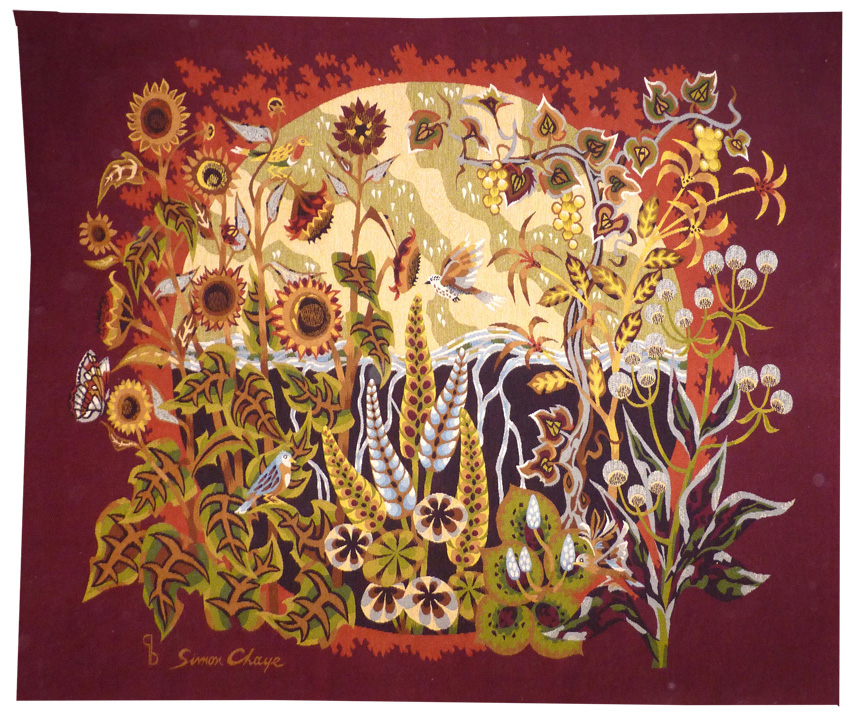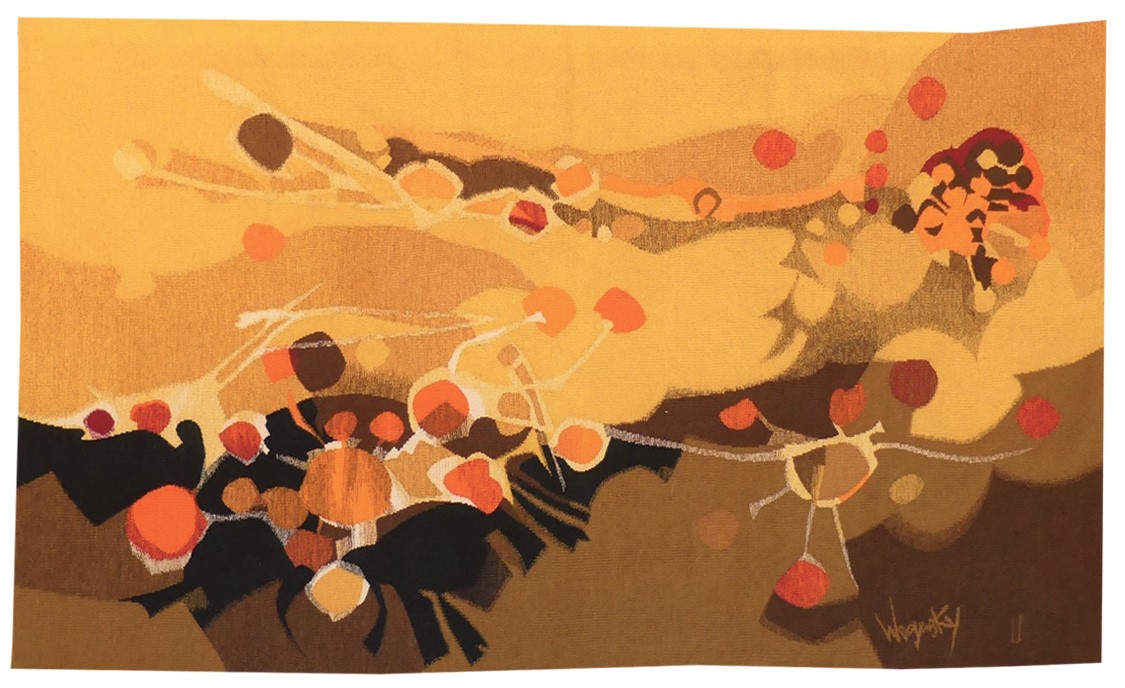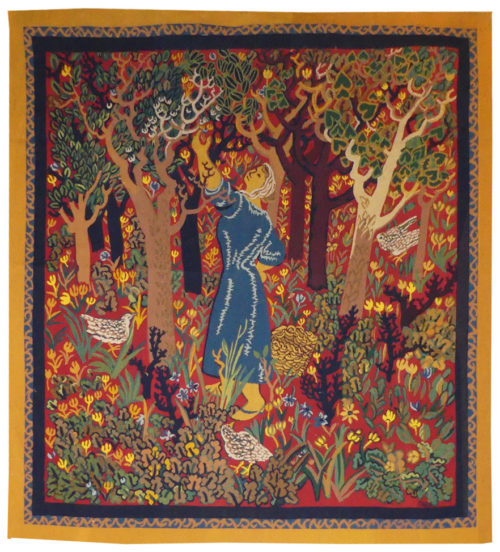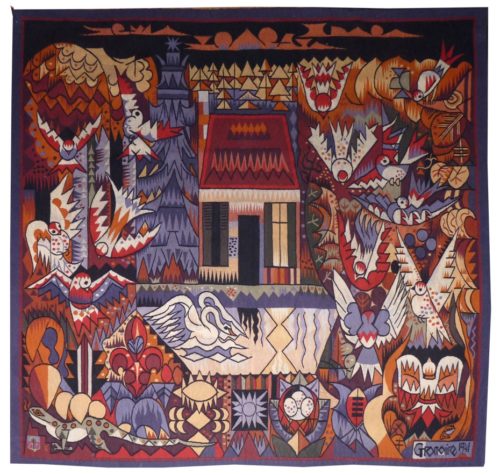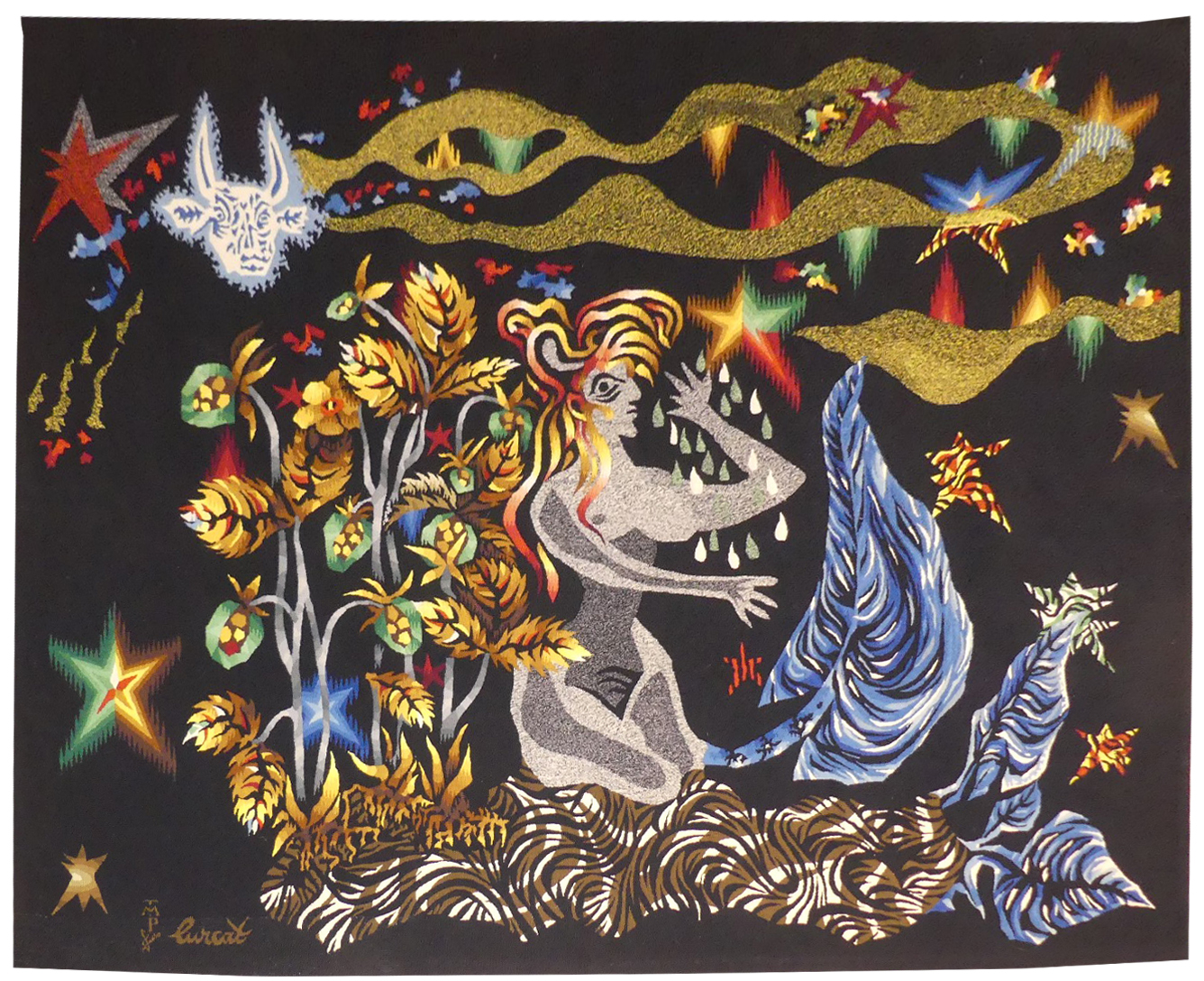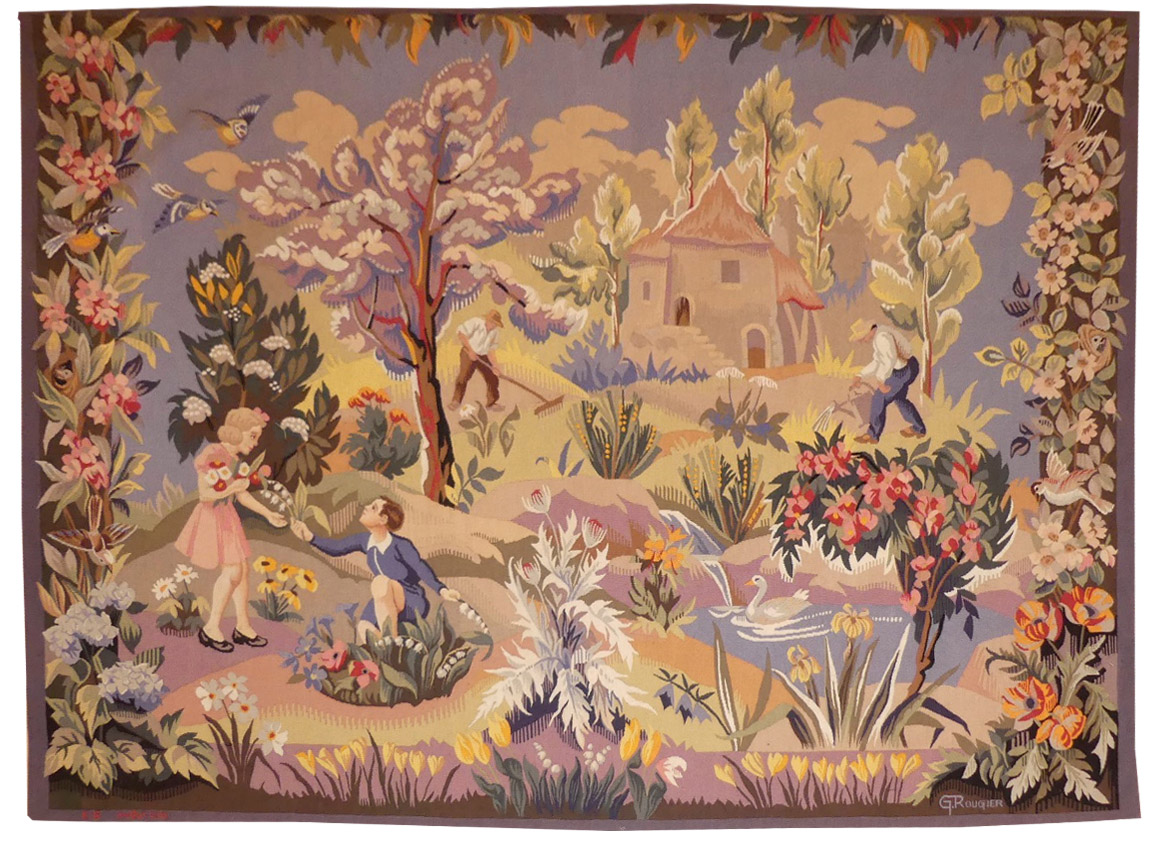-
Aubusson tapestry woven by the Legoueix workshop. With signed label, n°3/4. 1968.A member of the A.P.C.T. (Association des Peintres-Cartonniers de Tapisserie), Wogensky is one of the many artists who would follow in Lurçat’s footsteps immediately after the war. At first influenced by his predecessor, Wogensky’s subsequent work (159 cartoons according to the 1989 exhibition catalogue) would evolve during the 1960’s towards a, not completely self-avowed, lyrical abstraction, from cosmic-astronomical themes expressed in decomposed, moving, birdlike shapes to cartoons both more refined and less dense. Although always claiming to be a painter, the artist’s conception of tapestry is extremely well thought out : “the realisation of a mural cartoon.... requires the consideration of a space which is no longer ours alone, by the nature of its dimensions, its scale, it also imposes a grand gesture which transforms and accentuates our presence.” « Procyon » is a work inspired by Wogensky’s « cosmic » vein (it’s title alone bears witness to the fact) which lasted through the 1960’s and of which “Cosmos” (1968 Strasbourg University) and “Galaxy” (1970, Sénat Palais du Luxembourg) would be the high points. Shading (omnipresent) and blocks of colour co-exist in a subtle harmony, evoking a curious, unknown world with elements of the infinitely small as seen through a microscope and the infinitely large. A similar tapestry is kept at the Musée Jean Lurçat et de la Tapisserie Contemporaine in Angers. Bibliography : Exhibition catalogue Robert Wogensky, Aubusson, Musée départemental de la tapisserie, 1989 Exhibition catalogue Robert Wogensky, Angers, Musée Jean Lurçat et de la Tapisserie Contemporaine, 1989 Exhibition catalogue Tissages d’ateliers, tissages d’artistes, 10 ans d’enrichissement des Collections, Angers, Musée Jean Lurçat et de la Tapisserie Contemporaine, 2004, ill. p.101 Exhibition catalogue Collections ! Collections !, Angers, Musée Jean Lurçat et de la Tapisserie Contemporaine, 2019-2020, ill. p.11
-
La cueillette (Harvest)
Tapestry. 1943. Artiste polyvalent (graveur, médailleur, céramiste, fresquiste…), Savin est sollicité pendant la guerre par Guillaume Janneau, qui admire la monumentalité intemporelle et réaliste de son esthétique (et dont il soupçonnait qu’elle n’aurait nul besoin de transposition pour convenir à la Tapisserie), pour concevoir des cartons pour les Manufactures Nationales : « les plaisirs et les travaux champêtres » ( 4 cartons), puis les « 12 mois de l’année » sont créés simultanément à son travail avec la Compagnie des Arts Français. L’influence des aspects techniques de la tapisserie médiévale est très prégnante chez l’artiste, attentif aux colorants naturels en gamme réduite, aux formes simples permises par la technique du gros point,… Il fut l’un des artistes les plus représentés à l’exposition séminale de 1946, avec 7 pièces (seuls Lurçat, Saint-Saëns et Gromaire en eurent plus). « La cueillette » est contemporaine du carton conçu pour les Gobelins : « La cueillette des pommes », issue de la tenture sur « les plaisirs et travaux champêtres ». On y trouve les mêmes caractéristiques propres à l’artiste : gamme chromatique limitée mais vive, formes simplifiées et monumentales, densité de la composition, et une saveur rustique tout droit venue de la tapisserie médiévale. Bibliographie : Cat. Expo. La tapisserie française du Moyen-âge à nos jours, Paris, Musée d’art moderne, 1946 Cat. Expo. Le Mobilier National et les Manufactures Nationales sous la IVe République, Beauvais, Galerie nationale de la Tapisserie, 1997 Cat. Expo. La Manufacture des Gobelins dans la 1ère moitié du XXe siècle, Beauvais, Galerie nationale de la Tapisserie, 1999 -
La mare aux oiseaux (The bird pond)
Aubusson tapestry woven in the Goubely workshop. N° II. 1941. Gromaire’s woven pieces are few in number : 11 cartoons, designed between 1938 and 1944, most of them in Aubusson. “His rigorous construction, his use of simplification, his penchant for grand composition and grand fundamental ideas, his knowledgeable use of colour and in sum his supreme quality as a master-craftsman, all of those things were to make of him one of the most expert tapestry artists of his time”, so wrote Jean Cassou (Exhibition catalogue, Marcel Gromaire, Paris, Musée Nationale d’art moderne, 1963). It was Guillaume Janneau, then in the chair of the Mobilier National, who contacted him in 1938, convinced that his style (simplification of shape, geometrical designs framed in black, influenced by cubism, limited colour schemes…) would have something to contribute to the resolution of the new aesthetic problems that the art of tapestry would have to confront in order to bring about its renewal (simplified palette, synthetic cartoon design...) firstly with a commission for a work on the theme of the four elements, then with a second (“les saisons”, the seasons) which would be produced at Aubusson. In 1940 Gromaire joined Lurçat and Dubrueil there. Working alone, with great meticulosity (numerous drawings anticipate the cartoon which is painted rather than numbered as with Lurçat), in close collaboration with Suzanne Goubely, who would weave all his cartoons, he spent 4 years in Aubusson, during which time he devoted all his creative energy to tapestry. At the end of the war, he left the Creuse and produced no more cartoons, leaving to Lurçat the position of grand initiator of the tapestry renewal movement. The bird pond is typical of the aesthetic expressed by Gromaire in his tapestries, by its extremely decorative, almost dream-like quality (quite different from his graphic works), by the choice of subject, both animal and vegetable (and even architectural) and particularly influenced by the Creuse region. It is the extraordinary density, the proliferation and profusion which are particularly striking and which make Gromaire’s work in textile so inimitable. Bibliography : Le Point, Aubusson et la renaissance de la tapisserie, mars 1946, ill. p.34 Muraille et laine, éditions pierre Tisné, 1946, ill. n°51 Exhibition catalogue Tapisseries d’Aubusson, Luxembourg, Galerie d’art municipale, 1982, n° 3 Exhibition catalogue, Gromaire, œuvre tissée, Aubusson, Musée de la tapisserie, 1995, ill. on p 51 Exhibition catalogue La manufacture des Gobelins dans la première moitié du XXe siècle, Beauvais, Galerie nationale de la tapisserie, 1999. -
Eve
Lurçat’s artistic production was immense : it is however his role as the renovator of the art of tapestry design which ensures his lasting renown. As early as 1917, he started producing works on canvas, then in the 20’s and 30’s, he worked with Marie Cuttoli. His first collaboration with the Gobelins workshop dates back to 1937, at the same time he discovered the tapestry of the Apocalypse which was essential in his decision to devote himself to tapestry design. He first tackled the technical aspects with François Tabard, then on his installation at Aubusson during the war, he established his technique : broad point, a simplified palette, outlined cartoons with colours indicated by pre-ordained numbers. A huge production then follows (over 1000 cartoons) amplified by his desire to include his painter friends, the creation of the A.P.C.T. (Association des Peintres-Cartonniers de Tapiisserie) and the collaboration with the art gallery La Demeure and Denise Majorel, and then by his role as a tireless advocate for the medium around the world. His tapestries reveal a pictorial world which is specifically decorative, with a very personal symbolic iconography : cosmogony (the sun, the planets, the zodiac, the four elements…) stylised vegetation, fauna (rams, cocks, butterflies, chimera …) standing out against a background without perspective (voluntarily different from painting) and, in his more ambitious work, designed as an invitation to share in a poetic (he sometimes weaves quotations into his tapestries) and philosophical (the grand themes are broached from the wartime period onwards) vision whose climax is the “Chant du Monde” (Song of the World) (Jean Lurçat Museum , ancien hôpital Saint Jean, Angers) which remained unfinished at his death. The total or partial re-use of cartoons is a characteristic of Lurçat’s working method : thus Eve is a replica in reverse of « La Poésie » (poetry), the antepenultimate panel of the « Chant du monde » series. Here the human face (? figure?) which had long been absent in the artist’s work, reappears. Was it his intention to create a biblical figure, an incarnation of woman, a poetic evocation, a sign of the zodiac (Virgo?)? The given title is Eve, probably out of respect for the artists widow’s wishes. Bibliography : Tapisseries de Jean Lurçat 1939-1957, Pierre Vorms Editeur, 1957 Exhibition Catalogue Lurçat, 10 ans après, Musée d'Art moderne de la ville de Paris, 1976 Exhibition catalogue Les domaines de Jean Lurçat, Angers, Musée Jean Lurçat et de la tapisserie contemporaine, 1986 Symposium Jean Lurçat et la renaissance de la tapisserie in Aubusson, Aubusson, Musée départemental de la tapisserie 1992 Exhibition Catalogue Dialogues avec Lurçat, Musées de Basse-Normandie, 1992 Exhibition catalogue Jean Lurçat, Donation Simone Lurçat, Académie des Beaux-Arts, 2004 Jean Lurçat, le chant du monde Angers 2007 Gérard Denizeau, Jean Lurçat, Liénart, 2013 Exhibition Catalogue Jean Lurçat au seul bruit du soleil, Paris, galerie des Gobelins, 2016Tapestry woven in the Fino workshop, Portalegre. With label signed by the artist's widow. 1962. -
Idylle pastorale (pastoral idyll)
Georges Rougier, who taught drawing at school in Aubusson, produced numerous cartoons for the Aubusson workshops and the Mobilier National, and worked alongside Marius Martin when he was head of ENAD. Along with Maingonnat and Faureau, Martin made him one of the main protagonists of a pictorial aesthetic resolutely turned towards tapestry, which was expressed in particular at the Exposition Internationale des Arts Décoratifs in Paris in 1925 (Rougier also had his own stand there!). Bibliography : Exhibition Catalogue « Tapisseries 1925. Aubusson, Beauvais, les Gobelins à l’Exposition Internationale des Arts Décoratifs de Paris », Aubusson, Cité de la Tapisserie, 2012Aubusson tapestry. Circa 1930.


